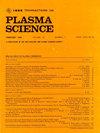The Spatial Resolution Effect of N2/O2 on Atmospheric Pressure Ar Plasma Jet
IF 1.3
4区 物理与天体物理
Q3 PHYSICS, FLUIDS & PLASMAS
引用次数: 0
Abstract
The atmospheric pressure low-temperature plasma jet (APPJ) can generate a wide variety of excited and active particles, with broad application prospects. Due to the strong spatiotemporal distribution characteristics of particles, the physical and chemical properties of plasma jets can be adjusted by changing the type and ratio of working gas, which is crucial for improving jet treatment efficiency and achieving specific treatment effects. This article innovatively analyzes the variations in the spatial distribution, intensity distribution, and activation region distribution of short-lived active substances that are crucial in the application of plasma jets under different gas backgrounds. Under the context of multiple variables, the physical characteristics of the plasma jets are comprehensively analyzed. The results show that the addition of N2 and O2 will weaken the discharge current and power, especially oxygen. After doping with 1% nitrogen, the jet length remains basically unchanged, but after doping with 1% oxygen, the jet length sharply decreases. Most active substances are concentrated at the nozzle of the jet pipe. The activation region ofN2/O2 对大气压氩等离子体射流的空间分辨率影响
常压低温等离子体射流(APPJ)可以产生多种受激和活性粒子,具有广阔的应用前景。由于粒子具有较强的时空分布特征,因此可以通过改变工作气体的类型和比例来调节等离子体射流的物理化学性质,这对于提高射流处理效率和达到特定的处理效果至关重要。本文创新性地分析了在不同气体背景下等离子体射流应用中至关重要的短寿命活性物质的空间分布、强度分布和活化区域分布的变化。在多变量背景下,对等离子体射流的物理特性进行了综合分析。结果表明,N2和O2的加入会减弱放电电流和放电功率,尤其是氧气的加入。服用1后% nitrogen, the jet length remains basically unchanged, but after doping with 1% oxygen, the jet length sharply decreases. Most active substances are concentrated at the nozzle of the jet pipe. The activation region of $\mathrm {OH}(\mathrm {A}^{2}\Sigma ^{+}\to \mathrm {X}^{2}{\Pi })$ is significantly lower than that of $\mathrm {N}_{2}(\mathrm {C}^{3}\Pi _{\mathrm {u}}\to \mathrm {B}^{3}\Pi _{\mathrm {g}})$ . As the N2 content increases from 0% to 1%, the activation region of $\mathrm {OH}(\mathrm {A}^{2}\Sigma ^{+}\to \mathrm {X}^{2}\Pi)$ decays from 17 to 12 mm and the activation region of $\mathrm {N}_{2}(\mathrm {C}^{3}{\Pi }_{\mathrm {u}}\to \mathrm {B}^{3}\Pi _{\mathrm {g}})$ remains unchanged, but the intensity of $\mathrm {N}_{2}(\mathrm {C}^{3}\Pi _{\mathrm {u}}\to \mathrm {B}^{3}\Pi _{\mathrm {g}})$ spectral line rises rapidly. As the O2 content increases from 0% to 0.1%, the activation region of $\mathrm {OH}(\mathrm {A}^{2}{\Sigma }^{+}\to \mathrm {X}^{2}{\Pi)}$ has decayed below 10 mm. The intensity of $\mathrm {N}_{2}(\mathrm {C}^{3}{\Pi }_{\mathrm {u}}\to \mathrm {B}^{3}\Pi _{\mathrm {g}})$ spectral extremely reduced by 48%. The increase in N2 content will lead to an increase in vibration and rotation temperature, while O2 is the opposite. From the axial spatial distribution, the vibrational temperature does not change much, but the rotational temperature decreases with increasing distance from the electrodes and eventually reaches equilibrium with the room temperature of 295 K.
本文章由计算机程序翻译,如有差异,请以英文原文为准。
求助全文
约1分钟内获得全文
求助全文
来源期刊

IEEE Transactions on Plasma Science
物理-物理:流体与等离子体
CiteScore
3.00
自引率
20.00%
发文量
538
审稿时长
3.8 months
期刊介绍:
The scope covers all aspects of the theory and application of plasma science. It includes the following areas: magnetohydrodynamics; thermionics and plasma diodes; basic plasma phenomena; gaseous electronics; microwave/plasma interaction; electron, ion, and plasma sources; space plasmas; intense electron and ion beams; laser-plasma interactions; plasma diagnostics; plasma chemistry and processing; solid-state plasmas; plasma heating; plasma for controlled fusion research; high energy density plasmas; industrial/commercial applications of plasma physics; plasma waves and instabilities; and high power microwave and submillimeter wave generation.
 求助内容:
求助内容: 应助结果提醒方式:
应助结果提醒方式:


